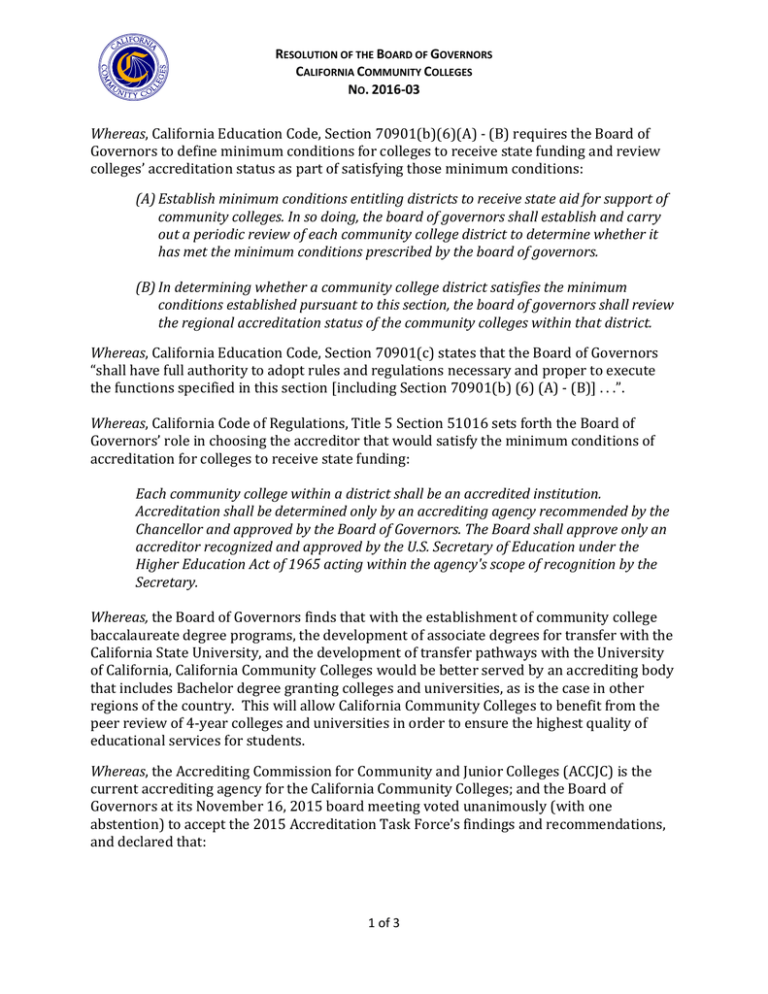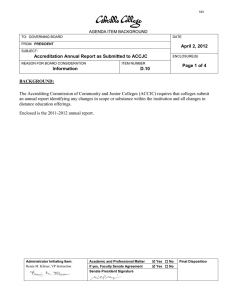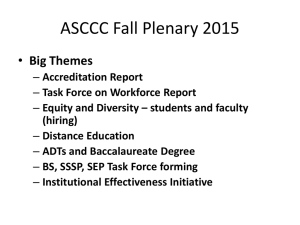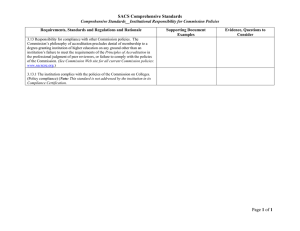Whereas Governors to define minimum conditions for colleges to receive state... colleges’ accreditation status as part of satisfying those minimum conditions:
advertisement

RESOLUTION OF THE BOARD OF GOVERNORS CALIFORNIA COMMUNITY COLLEGES NO. 2016-03 Whereas, California Education Code, Section 70901(b)(6)(A) - (B) requires the Board of Governors to define minimum conditions for colleges to receive state funding and review colleges’ accreditation status as part of satisfying those minimum conditions: (A) Establish minimum conditions entitling districts to receive state aid for support of community colleges. In so doing, the board of governors shall establish and carry out a periodic review of each community college district to determine whether it has met the minimum conditions prescribed by the board of governors. (B) In determining whether a community college district satisfies the minimum conditions established pursuant to this section, the board of governors shall review the regional accreditation status of the community colleges within that district. Whereas, California Education Code, Section 70901(c) states that the Board of Governors “shall have full authority to adopt rules and regulations necessary and proper to execute the functions specified in this section [including Section 70901(b) (6) (A) - (B)] . . .”. Whereas, California Code of Regulations, Title 5 Section 51016 sets forth the Board of Governors’ role in choosing the accreditor that would satisfy the minimum conditions of accreditation for colleges to receive state funding: Each community college within a district shall be an accredited institution. Accreditation shall be determined only by an accrediting agency recommended by the Chancellor and approved by the Board of Governors. The Board shall approve only an accreditor recognized and approved by the U.S. Secretary of Education under the Higher Education Act of 1965 acting within the agency's scope of recognition by the Secretary. Whereas, the Board of Governors finds that with the establishment of community college baccalaureate degree programs, the development of associate degrees for transfer with the California State University, and the development of transfer pathways with the University of California, California Community Colleges would be better served by an accrediting body that includes Bachelor degree granting colleges and universities, as is the case in other regions of the country. This will allow California Community Colleges to benefit from the peer review of 4-year colleges and universities in order to ensure the highest quality of educational services for students. Whereas, the Accrediting Commission for Community and Junior Colleges (ACCJC) is the current accrediting agency for the California Community Colleges; and the Board of Governors at its November 16, 2015 board meeting voted unanimously (with one abstention) to accept the 2015 Accreditation Task Force’s findings and recommendations, and declared that: 1 of 3 RESOLUTION OF THE BOARD OF GOVERNORS CALIFORNIA COMMUNITY COLLEGES NO. 2016-03 “[T]he Board of Governors hereby directs the Chancellor, working through the system’s established consultation processes, to bring to the Board of Governors at its March 2016 meeting: 1. A recommendation for action to establish a new model for an accrediting agency; and 2. An implementation plan, along with timeline.” Whereas, ACCJC is at risk of losing recognition by the U.S. Department of Education. As outlined in a January 4, 2016 letter, the Secretary of Education, United States Department of Education (Docket No. 14-10-O) found that ACCJC must submit a compliance report on sections 602.13 and 602.15 (a)(3) by January 4, 2107 to maintain its recognition by the U.S. Department of Education. Specifically, the ACCJC was found not to be in compliance with: i) ii) 34 C.F.R § 602.13(a) which states that an accrediting agency “must demonstrate that its standards, policies, procedures and decisions to grant or deny accreditation are widely accepted in the United states by,” among others “educators and educational institutions”; 34 C.F.R. § 602.15(a)(3) which states that accrediting agency must demonstrate that it has “academic and administrative personnel on its evaluation, policy and decision-making bodies, if the agency accredits institutions.” Whereas, the Chief Executive Officers of the California Community Colleges have primary responsibility for representing their institutions in matters pertaining to accreditation, and are the member institutional representatives to the ACCJC. Whereas, the Chief Executive Officers are committed to peer review as the most important aspect of the regional accreditation process. Whereas, the Chief Executive Officers overwhelmingly resolved on March 14, 2016 that they lead the process to make fundamental changes to accreditation process and structures, including structuring regional accreditation that more closely aligns all segments of higher education. Whereas, the Chief Executive Officers overwhelmingly agreed to pursue changes by immediately forming two representative planning groups to (a) “develop and recommend improvements regarding the ACCJC,” and (b) “facilitate communication leading to the longrange goal of California’s community colleges participating in a structure for regional accreditation that aligns all segments of higher education.” THEREFORE, BE IT RESOLVED, at its March 21-22 board meeting that the Board of Governors accepts the report from the Chancellor based in part on the work of the 2016 Task Force on Accreditation Implementation. 2 of 3 RESOLUTION OF THE BOARD OF GOVERNORS CALIFORNIA COMMUNITY COLLEGES NO. 2016-03 BE IT FURTHER RESOLVED that the Board of Governors directs the Chancellor to: 1. Notify ACCJC that the Board of Governors supports the direction set by the Chief Executive Officers of the California Community Colleges to pursue a new direction in accreditation process and structure; 2. Support the Chief Executive Officers and their colleges in coordination of planning groups to: a. Recommend immediate changes to improve the existing processes and culture of ACCJC including, but not limited to, enhanced financial transparency, reformed governance and leadership, better communication with member institutions, and more effective training during the next two years to ensure continuity of accreditation for the system’s colleges, and b. Lead a change in accreditation structure that aligns all segments of higher education in California, including coordinating planning discussions with the WASC Senior College and University Commission (WSCUC) as well as the other community colleges in California that are not in our system and the community colleges of Hawaii and the Pacific islands currently accredited by ACCJC; 3. Provide Chancellor’s Office support to the CEOs as they engage key constituent groups and help coordinate activities during this process; 4. Identify and advocate for resources to ensure an efficient transition; 5. Provide periodic updates to the Board of Governors on progress toward implementation of changes including a progress report at the July 2016 meeting; and 6. Upon the U.S. Department of Education’s approval of any new structure or agency for accreditation of the California Community Colleges, review the formal plan for college transition and bring to the Board of Governors the necessary information to designate a new accreditor for the California Community Colleges. 3 of 3




